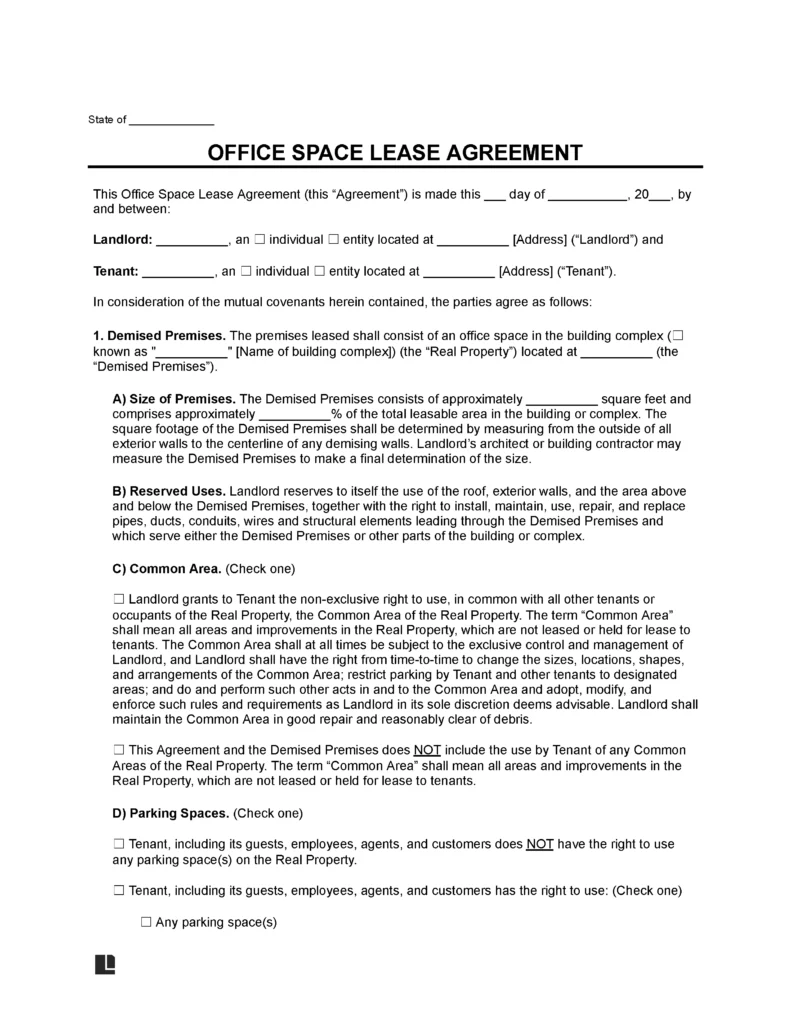An office space lease agreement is a legal document between a landlord and a tenant outlining the rental of office space, suites, or shared workspaces for office-related use. Rent is typically calculated on a price per square foot ($/SF) and is usually paid monthly, covering amenities, services, and utilities. The agreement details the obligations of both parties.
This agreement is intended for commercial use only and should not be used for retail or residential purposes
Related Form
Commercial Lease Application Form – Use this form to verify the tenant’s credit history and background.
Renting Office Space In 8 Steps
Step 1 – Evaluate Your Needs
For Owners or Landlords:
- Assess the Space: Determine the exact square footage, amenities, and expenses covered in the lease.
- Subleasing: Ensure subleasing is permitted within the current contract if applicable.
- Rent Calculation: Calculate rental rates on a per-square-foot basis.
- Utility Allocation: Decide which utilities to include and which will be the tenant’s responsibility.
- Lease Details: Finalize lease terms (e.g. length of lease) to determine the type of tenant and streamline the tenant search process.
For Prospective Tenants:
- Budget: Establish your rental payment budget.
- Space Requirements: Determine the desired square footage.
- Lease Duration: Decide on the preferred lease length.
- Office Class: Choose the class of office space (A, B, or C).
- Desired Features: Identify sought-after features, amenities, and location.
- Consider Stakeholders: Incorporate the needs of employees and clients in your decision-making process for a more effective workspace.
Step 2 – Search for Office Space (For Tenants)
Start by exploring online resources such as CommercialSearch, LoopNet, Digsy, Crexi, and OfficeList to find available office spaces for general listings.
These platforms offer flexible lease terms, often allowing cancellation with just 30 days’ notice. Committing to a 6-month or 1-year lease usually results in better rates.
Step 3 – Arrange Property Viewings (For Tenants)
Once you’ve identified potential properties, arrange viewings. During these visits, the landlord or property manager will provide details such as move-in dates, monthly rent, available space, and other specifics.
Step 4 – Lease Terms Negotiation
After selecting the best space, negotiate the lease terms with the landlord. Consider comparing two properties to secure the best rate.
Step 5 – Tenant Verification
After a verbal agreement, the landlord will verify the tenant’s identity and financial stability using a Rental Application. This process may include checking financial statements and business records, as well as performing credit and background checks.
Tenants with low credit scores often need a lease guarantor to secure their rental agreement. This involves having an individual or entity guarantee the lease.
Step 6 – Make Sure You Have All the Required Documents
Below is a detailed list of supplementary documents that may be required:
- Property Registration Document: Provides proof of ownership or authorization of the landlord to lease the office space.
- Identity Proof: For both parties.
- Address Proof: Utility bills or bank statements for both parties.
- Security Deposit Receipt: Sometimes, a receipt for the security deposit paid by the tenant may also be required.
- Witness Statements: Statements from witnesses who can attest to the signing of the agreement by both parties, if required.
Step 7 – Finalizing the Office Lease
Once everything is in order, it’s time to sign the lease. There are three ways to do this:
- eSignature
- Handwritten Signature
- Notary Acknowledgment: Used especially for large-scale leases done in the presence of a notary public.
Step 8 – Moving In
After signing the lease, the tenant will need to pay the security deposit (if applicable) and the first month’s rent. Once these payments are made, the space is ready for occupancy!
What to Include in an Office Lease
Term
Specify the start and end dates of the lease. Typically, leases for smaller spaces (under 2,000 SF) run for 1-2 years, while larger spaces often require 3-5 year commitments.
Tenants may request renewal options at predetermined rent increases, often tied to the Consumer Price Index (CPI).
Rent
Rent usually includes a base amount paid monthly and a share of property expenses such as real estate taxes, property insurance, and common area maintenance (CAM) costs. A security deposit, typically one month’s rent, is also common to cover potential lease breaches.
Specific Use Clause
This clause restricts the use of the space to office-related activities, ensuring quiet enjoyment for other tenants. Common restrictions include:
- No food preparation.
- No medical procedures.
- Limit noise levels (e.g., no activities above 80 decibels).
- No retail operations.
- No hazardous materials.
Delivery of Space
Landlords can deliver the space in three ways:
- As-Is: Tenant accepts the space in its current condition.
- Vanilla Box: Space is delivered with basic finishes like white paint, ready for move-in.
- Custom Build-Out: Landlord completes the space according to the tenant’s specifications.
Amenities
Landlords often include amenities such as high-speed internet, dedicated parking, 24-hour security, meeting rooms, reception areas, fitness centers, daycare facilities, and on-site food and beverages to attract tenants.
Leasehold Improvements
Tenants may be allowed to perform construction but will generally need to revert the space to its original condition if required by the landlord.
Sample Office Space Lease Agreement
Download a template in PDF or MS Word below.


